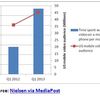Alcatel-Lucent’s Rich Crowe continues the dialogue on the Six Degrees of Mobile Data Plan Innovation by examining recent market developments in third party pays mobile data.
Syntonic Wireless™ is bringing sponsored data to AT&T customers. The Seattle-based mobile services company’s new Syntonic Sponsored Content StoreSM, creates an open marketplace where AT&T’s iOS and Android customers can find and consume free or premium content without consuming their data plans. Integrated with AT&T’s Sponsored DataSM service, the Syntonic Sponsored Content Store operates on the third party pays concept, one of the six degrees of mobile data plan innovation.
When it announced Sponsored Data in January 2014, AT&T offered a vision for a service that would give sponsors new ways to engage with customers and employees. Sponsors could come from industries as diverse as healthcare, retail, media and entertainment, and financial services. They could use sponsored data in a variety of different ways, including:
- Encouraging customers to try new apps
- Promoting movie trailers or games
- Providing healthcare support through wellness videos
- Attracting customers to mobile shopping sites
- Allowing businesses with bring-your-own-device (BYOD) policies to pay for employees’ work-related data use
- Enhancing customer loyalty programs with sponsored access to data products and services
These examples don’t require sponsors to buy large quantities of data. Videos would be a few minutes long at most, and would not necessarily require HD quality.
If sponsorship deals don’t enable most customers to reduce the amount of data they purchase — either because the amount of sponsored data is too small or the sponsored applications don’t merit frequent use — the service provider can treat the sponsor’s payments as incremental revenue. Prices can be lower than those offered to the consumer. In fact, sponsors may argue they deserve a discount for buying large volumes of data or committing to a minimum purchase while not receiving enhanced speeds. Service providers need to manage expectations around pricing for customers: Since customers’ wireless bills don’t shrink, some may accuse service providers of charging twice for the same data.
On the other hand, if some customers can use sponsored data to reduce their monthly data plan, service providers will need to keep sponsor pricing in line with what the average consumer pays for data. Otherwise providers risk delivering the same amount of data but getting less revenue for the sponsored portion, causing margins to decline. If sponsored data prices are not meaningfully discounted, use cases will continue on current trends and be relatively light on data consumption. Sponsoring data at normal consumer prices for a data-heavy application, like streaming video, will be costly.
Pricing aside, how can sponsored data offers be structured? While by no means a complete list, here are five possibilities that can provide benefits to service providers, sponsors and customers alike:
- Unlimited sponsored data: The content provider pays for all data that subscribers use in consuming its content. This consumption has no limits and does not require a separate subscription. The content provider can generate revenue by upselling premium content or by leveraging increased traffic to attract on-site advertisers. In some cases costs savings may be realized — for example, a health insurer offering sponsored wellness videos to reduce future insurance claims. A variant of this approach is to put a time limit (for example, 30 days) on the unlimited sponsorship as a marketing tool to introduce new content and attract new customers. After the sponsorship period ends, customers’ data plans are once again consumed when they use the provider’s content.
- Enterprise-sponsored data: An enterprise that supports a BYOD policy pays for employees’ business-related data use. Personal data use continues to be charged against employees’ own data plans.
- Subscriber-sponsored data: The content provider pays for all data that subscribing customers consume on its site. Customers subscribe directly with the content provider for a flat monthly fee, part of which can flow to the service provider to cover the data consumed. The content provider may also garner increased advertising revenues by drawing more traffic to its site.
- Limited sponsored data – By device/account: The content provider sponsors a maximum amount of data for each device or account. Use above the maximum counts against the customer’s data plan or triggers an invitation to subscribe to the content (as part of a subscriber-sponsored data plan). This approach can be used as a marketing tool to introduce new content or applications.
- Limited sponsored data – By total consumption: The content provider sponsors a maximum amount of data, which is made available for use by all customers. The sponsorship ends when this maximum is reached. Continued use of the content either consumes customer data plans or triggers invitations to subscribe to the content to keep the sponsored data. This approach can be used to market the launch of new content or applications. For the data sponsor, it eliminates the risk of not knowing how much data will be consumed.
These scenarios illustrate a few of the many ways that sponsored data can be used to market new content and applications, drive subscription campaigns, help enterprises address some of the challenges of supporting BYOD policies, or even reduce cost. In scenarios where data sponsorship ends after a time limit or consumption threshold is reached, communication by both the service provider and content provider will be key to avoiding customer dissatisfaction.
The toll-free data market is still nascent. We will see innovative third-party pays use cases emerge as service providers and content providers partner on new offers across industries. AT&T’s Sponsored Data and Syntonic’s Sponsored Content Store are key steps in bringing third-party pays data plan innovations to the market.
What other ideas do you have on how sponsored data offerings can be structured? Please add your thoughts to the comments section below or share them with me on Twitter @rhcrowe.
Download the Six Degrees of Mobile Data Plan Innovation e-book. Please follow us on TMCnet, and click here to subscribe for more information and updates.
Past blogs in this series:
- It’s Not All About Data: Mobile Voice and Messaging Share Plans Offer Plenty of Appeal
- Shared Data Plans: A Tool for Attracting and Retaining Subscribers
- Mobile Data Plans: The Options for Aligning Services with Consumer Needs
- Bringing customers closer: Six degrees of mobile data plan innovation
- Six Degrees of Mobile Data Plan Innovation: Service Level-based Plans
- Six Degrees of Mobile Data Plan Innovation: Shared Data Plans
- Six Degrees of Mobile Data Plan Innovation: Application-Based Plans
- Six Degrees of Mobile Data Plan Innovation: Third Party Pays
- Six Degrees of Mobile Data Plan Innovation: Loyalty-Based Plans
- Six Degrees of Mobile Data Plan Innovation: Capacity-Based Plans
- Coming Soon To A Mobile Operator Near You: The Six Degrees Of Mobile Data Plan Innovation











